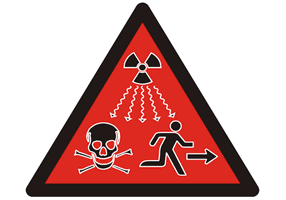Tritium releases opposed as environmental and health concerns grow

Reactor community residents, state and federal political officials, public health experts, fishing industry advocates and environmentalists in the United States and countries around the world are calling for stricter protective action to prevent the international nuclear industry’s global discharge of its largest, and costliest, volume of liquid radioactive waste from nuclear power sites; tritium, radioactive hydrogen (3H).
In the US, Massachusetts and New York government officials have joined with impacted communities and businesses around two large nuclear power decommissioning projects to oppose large radioactive discharges into aquatic environments by the same corporation, Holtec International Decommissioning (HID). HID has long planned to dump a massive volume of radioactive water into the environment from two of its decommissioning projects. An estimated 1.1 million gallons of the radioactive water is stored in the reactor spent fuel pool of the permanently closed Pilgrim station, Plymouth, MA. HID has designated Cape Cod Bay as its dumping ground for the liquid nuclear waste. Similarly, HID’s plan is to discharge another 1.3 million gallons of radioactive water currently stored in two spent fuel pools at the decommissioning Indian Point nuclear station into the Hudson River at Buchanan, NY.
Both reactor sites are said to be undergoing radioactive decontamination, dismantlement of systems, structures and components followed by radiological site remediation. But there is already very little public transparency into this process and a hands-off approach to its oversight by the Nuclear Regulatory Commission. The HDI discharge plan is considered the company’s “best” and least cost disposal option for the liquid radioactive waste. Though HDI claims that the contaminated water will be thoroughly treated to be “harmless” before release, Massachusetts state testing of the Holtec Pilgrim site determined that the untreated stored effluent is contaminated to extremely high levels (as much as 200 million times higher for some isotopes than Cape Cod Bay’s natural background level) with at least five radioactive isotopes that include tritium and “four ‘principle’ gamma radiation emitters: manganese-54, cobalt-60, zinc-65, and cesium-137” and possibly strontium-90. Scientists argue that at such high raw concentrations even after being treated and filtered the contamination would still be 2 million times higher than the ocean’s natural radiation background level.
With these direct discharges of the radioactive liquid effluent into the environment now blocked by state regulators, the health concern has now shifted through an anonymous whistleblower at the Pilgrim decommissioning site who is alleging that HDI has installed evaporators submerged in the spent fuel pool to discharge radioactive contaminated water vapor into the open atmosphere downwind and around the project site.
Internationally, the Japanese nuclear industry and its governmental regulators have started discharging large amounts of liquid radioactive waste into the Pacific Ocean without transparency into how much radioactivity it actually is. Because tritium cannot be be separated or removed from the volume of radioactive waste water and has only been partially treated the radioactive effluent , according to questioning scientists it is still contaminated with plutonium-239, strontium-90, cobalt-60 and cesium-137 and more. The liquid nuclear waste results from water be used for coolant coursing through the radioactive wreckage of three melted nuclear reactor cores since the 2011 Fukushima Daiichi nuclear catastrophe. The contaminated water has been accumulating over the past twelve years in now more than 1000 hastily constructed and very large industrial toxic storage tank since then. The still hot damaged reactor cores still require pumped circulation of cooling water, not passive cooling. Fukushima’s radiation filtration system “Advanced Liquid Processing System (ALPS), installed as a result the disaster, has not been consistently operational nor has it reliably treated the contaminated coolant water. Only 40% of the site’s radioactive water storage tanks have been sampled and tested over the past twelve years adding to a significant lack of transparency and growing international distrust of Japan’s government and industry’s response. Japan’s plan to indefinitely bleed the ongoing flow of partially treated radioactive effluent into the Pacific has caused intense international outrage and reputational damage to Japan throughout Asia. The call for boycotts of Japan’s fisheries and more broadly consumer goods including the Japanese cosmetics industry is growing louder.
Because radioactive tritium cannot be economically separated or filtered out of H2O (as water, vapor, ice or fog), the release of tritiated water (HT) has been deregulated. Dilution to pollution has become its only “solution.” But because tritium will “bioaccumulate” and then “biomagnify” as it concentrates up the aquatic food chain, chronic discharges of radioactive pollutants represent increasing health and economic risks to marine habitats, downwind and downstream communities and their general livelihood on these waters.
Tritium is often described by nuclear power proponents as a harmless “weak” external exposure field of beta radiation that will not penetrate paper or skin. However, when tritium is biologically internalized by ingestion and inhalation, the clinical science demonstrates that tritium’s chronic internal exposure is a carcinogen, mutagen and teratogen. Rather than a “weak” emitter, tritium is scientifically described by its physics as a “short range” beta emitter. That same science warns tritium delivers more energy on that “short track” that is more effective to cause cellular damage than gamma radiation’s penetrating “long track.” Tritium’s ability to readily displace stable hydrogen atoms at the most intimate biological levels includes the DNA chain. Tritium also easily passes through the placenta barrier from mother to fetus where biological cellular development is most active.
Support Beyond Nuclear
Help to ensure a safer, greener and more just world for all

